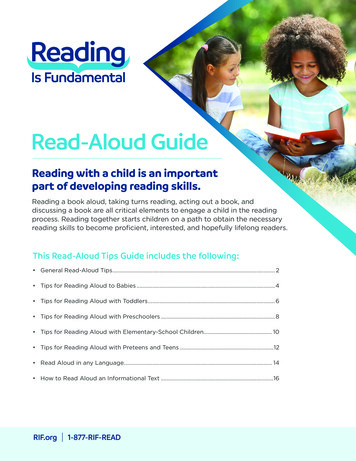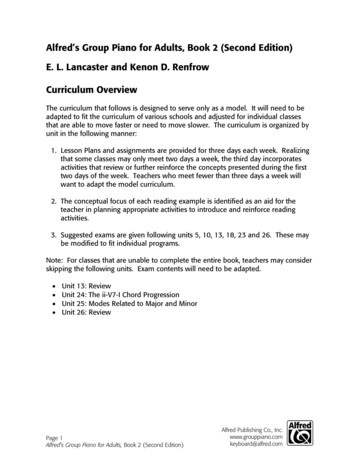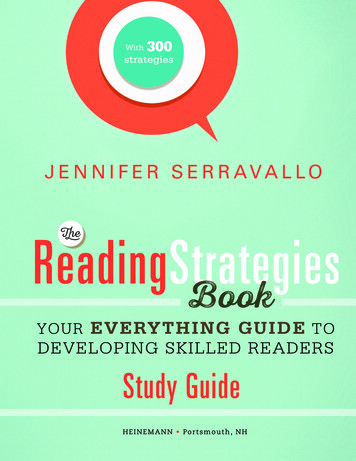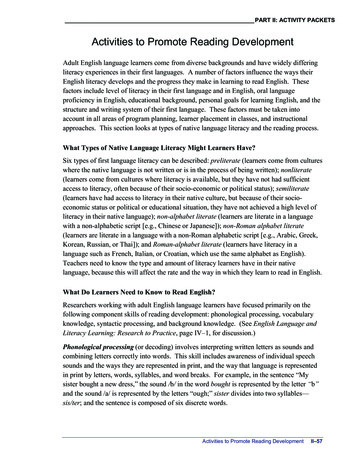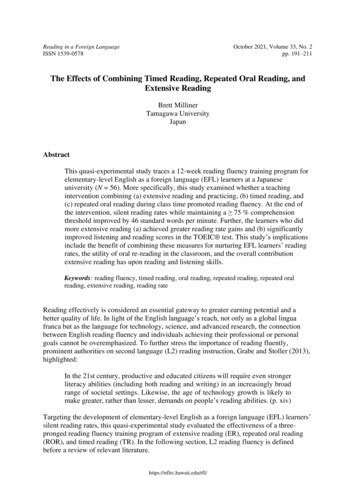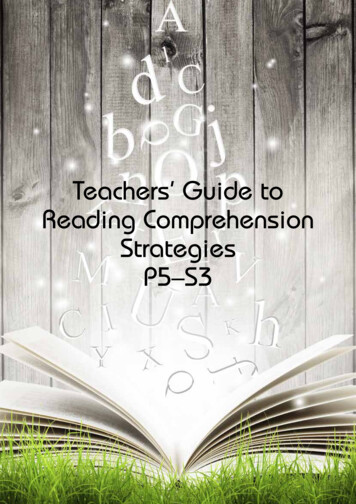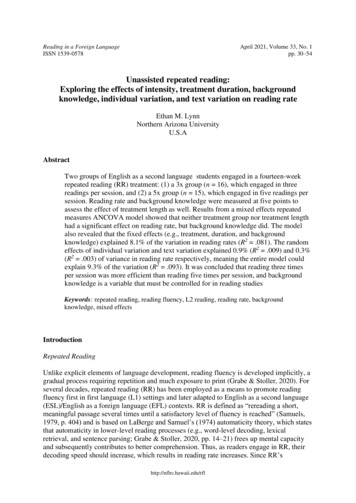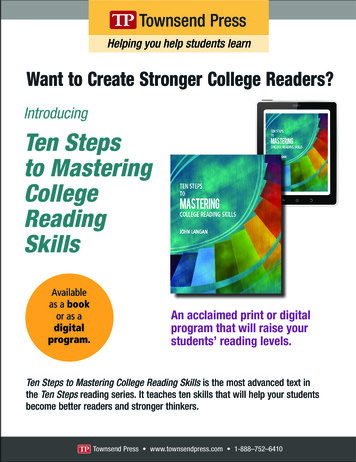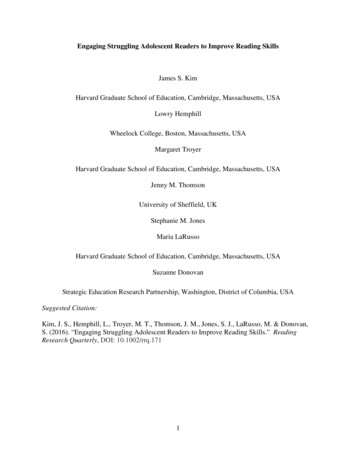
Transcription
READING GROUP GUIDETHE PREQUEL TO PRACTICAL MAGIC“Reading an Alice Hoffman book is like falling into a deep dreamwhere senses are heightened and love reigns supreme.”— jodi picoult, New York Times bestselling author of A Spark of Light
Magic L essonsALICE HOFFMANThis reading group guide for Magic Lessons includes anintroduction, discussion questions, ideas for enhancing yourbook club, and a Q&A with author Alice Hoffman.The suggested questions are intended to help your reading groupfind new and interesting angles and topics for yourdiscussion. We hope that these ideas will enrich your conversationand increase your enjoyment of the book.
IntroductionIn an unforgettable novel that traces a centuries-old curse to its source, belovedauthor Alice Hoffman unveils the story of Maria Owens, accused of witchcraftin Salem and matriarch of the amazing Owens family featured in Practical Magicand The Rules of Magic.Where does the story of the Owens bloodline begin? With Maria Owens, in the1600s, when she’s abandoned in a snowy field in rural England as a baby. Underthe care of Hannah Owens, Maria learns about the “Nameless Art.” Hannahrecognizes that Maria has a gift and she teaches the girl all she knows. It is herethat she learns her first important lesson: Always love someone who will loveyou back.When Maria is betrayed by the man who has declared his love for her, she followshim to Salem, Massachusetts. Here she invokes the curse that will haunt herfamily. And it’s here that she learns the rules of magic and the lesson that she willcarry with her for the rest of her life: Love is the only thing that matters.Magic Lessons is a celebration of life and love and a showcase of Alice Hoffman’smasterful storytelling.
Topics & Questions for Discussion1.This novel is both historical fiction and magical realism. How does Alice Hoffman blend bothgenres? What are examples from each genre in the book?2.Maria studies the Nameless Art under Hannah Owens and her mother, Rebecca. Hannah andRebecca have different values. What are they? How do those differences influence what theyteach Maria?3.Early in the novel, Rebecca teaches Maria, “Love could ruin your life or set you free; it couldhappen by chance or be a well-planned decision.” (45) How does this advice foreshadow Maria’srelationship with John Hathorne and Samuel Dias?4.There is a song that Maria recalls throughout her journey that starts with the lyric “The wateris wide, I cannot get oe’r it.” Think about when the song appears in the novel. How does themeaning of the lyrics change as Maria deals with new challenges and heartache?5.In Maria’s travels, she meets Jewish refugees from Spain and Portugal who have left their homecountries to escape persecution. How does Alice Hoffman weave Jewish history into the story?6.Maria encounters discrimination against women in both the old world and the new. In a worldwhere most women are illiterate and have no power Maria knows “a woman with her own beliefswho refuses to bow to those she believes to be wrong can be considered dangerous.” (107) Howdoes Maria rebel against societal constraints? How does she create her own fate?7.On her hanging day, Maria calls down a family curse as she seeks “to protect herself and herdaughter and any of their descendants from the grief she’d known.” (220) Does the cursesuccessfully protect her and Faith from grief?8.Note Maria’s relationship to Cadin, her crow, and Faith’s to Keeper. Crows are described as “moreloyal than any other man or beast” (35) and Keeper waits years for Faith to return. Have you everhad an emotional connection to an animal? Have you experienced empathy from an animal?
9.Faith is a talented witch and deeply loved by her mother, but after she’s kidnapped and heldprisoner, she changes. Faith takes up the Dark Arts and studies The Book of the Raven,interested in revenge. Do you think her anger at her father is justified? Do we sometimes lashout at those we love best?10.After reading the novel, reconsider the title. What are the “magic lessons” that Maria and Faithwere first taught and what are the lessons they learn to live by after overcoming suffering?11.Love is central to the story. Every character in the story is disappointed by love, but also needslove. Discuss the different types of love that are explored in this book.12.The Owens family curse continues for generations, but Maria still manages to save Samuel.How do they avoid the family curse?Enhance Your Book Club1.The Grimoire is a leather-bound book of spells that Hannah Owens gives to Maria.Collect words of wisdom, favorite sayings, and photographs to make your ownscrapbook Grimoire. What words, images, mantras, or recipes do you draw strengthfrom?2.Using a map, trace Maria’s journey throughout the world. Explore the history behindeach city in the same time period that Maria visits. What would she have encounteredduring her travels? Have you visited any of the locales yourself? Imagine what it wouldhave been like to walk in Maria’s shoes. How do you think it’s different now in modernday?3.Maria bakes apple pies for her daughter, Faith, but in the Boston teahouse where sheworks she makes bird’s nest pudding. Search for a recipe and try making your versionof this apple-cinnamon custard to enjoy with a pot of tea.
A Conversation with Alice Hoffman1.Magic Lessons continues the story of the beloved Owens family, taking us to the originsof the family curse. What inspired you to return to the Owens family after so many years?AH: My readers asked me for more of the Owens family, and I was intrigued by whattheir history might be. The character of Maria, who appears in the first book [PracticalMagic], always seemed as if she might have a great deal more to say.2.You have said that you always start a novel with a question. What was the question thatyou asked before writing this book and did you find your answer?AH: The question in Magic Lessons is how can those who are cursed in love manage tolive a life that includes love. How can people who are hurt and vulnerable and betrayedopen their hearts again?3.The story is rich with historical details, especially when Maria enters new citiesthroughout the world. What was the process behind your research?AH: I have been researching the Owens family for twenty-five years! I read a greatdeal of history, went to Salem, and read extensively about the witch trials. But I’m alsointerested in everyday details: recipes, how houses were built, clothing—that to me isthe beginning of building a world. I also do magic research, and have a magic librarywhich I have been collecting for years. For me, that is the fun part of my research.
4.A value that Hannah Owens imparts on Maria is kindness. It is a trait that Maria’sbiological mother, Rebecca, does not possess but Hannah teaches Maria to value. Whatinspired you to emphasize this trait?AH: In a cruel world it can be difficult to see that kindness is the way through the mazeof uncertainty. But then and now, kindness is always a trait to value.5.You explore the relationships between humans and animals through Maria and hercrow, Cadin, and Faith and her wolf, Keeper. Can you tell us about an animal that hasbeen special in your life?AH: Witches are said to have familiars, animals or birds who are soul mates. My soulmate was a German shepherd named Houdini, my dearest companion for sixteen years.6.There are different types of love in the novel. There is romantic love, demonstrated inthe relationship between Maria and Samuel Dias. There is also familial love betweenMaria and Faith. What did you want readers to learn from these different relationships?AH: The book is about love in its many forms. I think most readers take away whatthe story means to them, and what love means in their own lives.7.Faith’s journey is a realistically dark one. She is taken from her mother and held captivefor years, and subsequently turns to the Dark Arts for revenge. Did you plan her storybeforehand? Or did her character evolve in the process of writing the novel?AH: I didn’t plan Faith’s story. She was such a strong character, she took charge of herown life and I just sat by and watched. She’s so complicated and hurt and brave. I grewto love her, despite her turn to the Dark Arts.8.This book thematically resonates with Practical Magic and The Rules of Magic in thatpowerful women are at the forefront of the story. What women have inspired you inyour life?AH: My mother and grandmother always inspire me. My mother was a single motherin the early sixties, a social worker, a rebel, and a wonderful friend. My grandmother wasa Russian immigrant who supported her family and who loved me unconditionally. Myfirst story was about her, and I would likely not have been a writer without her support.
9.Your interest in fairy tales, myth, and fantasy comes through in many of your novels.Did you read any works which inspired you while writing Magic Lessons? How did thisinterest influence the writing of Magic Lessons?AH: I don’t read while I’m writing fiction—I don’t want to be influenced by otherstories or ideas. But the stories I read as a child and the books that I love are withme always. The Grimms’ fairy tales, the myths and legends, and the stories myRussian grandmother told me are always a part of what I write. In this case, NathanielHawthorne’s classic novel The Scarlet Letter was hugely influential.10.Can you tell us what you’re working on now?AH: I’m working on the fourth book in the Practical Magic series, called The Book ofMagic. It’s likely the last of the series as well, and takes place in modern times, so thatreaders find out what happened to Sally’s daughters, Kylie and Antonia, and they alsodiscover what happened to Vincent Owens. For me, it’s been a pleasure to spend moretime with the Owens family.
This book thematically resonates with Practical Magic and The Rules of Magic in that powerful women are at the forefront of the story. What women have inspired you in your life? AH: My mother and grandmother always inspire me. My mother was a single mother in the early sixties, a social wo

